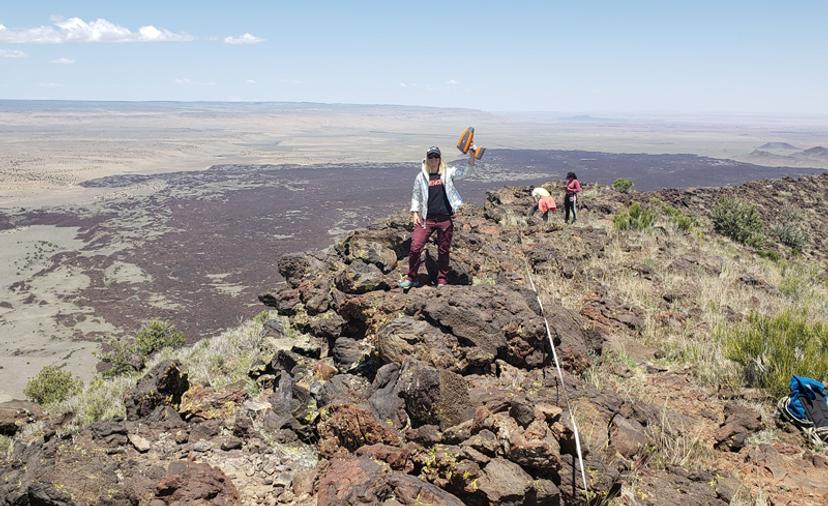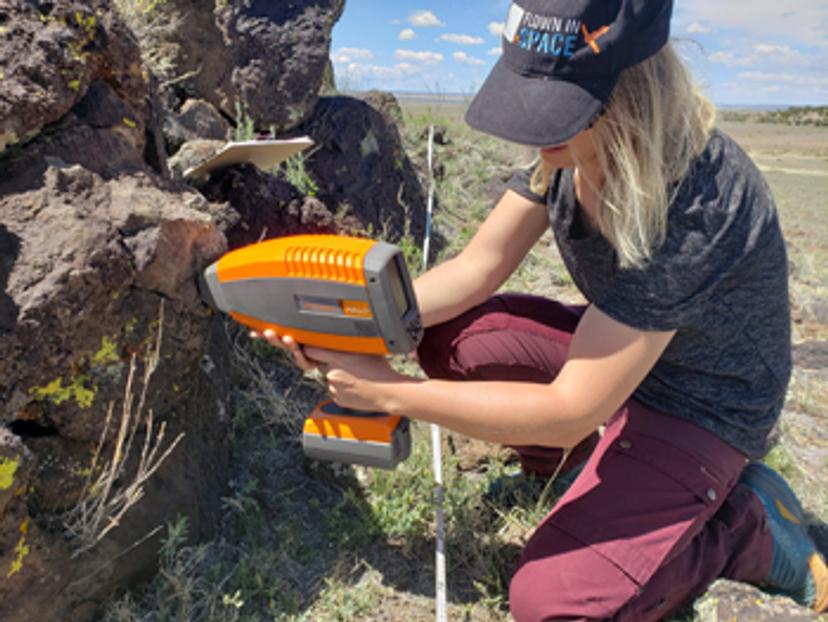Science in the Wild: How portable technology can reveal landscape-scale environmental changes
Explorer and scientist Ulyana Nadia Horodyskyj reveals how she reaches new heights in her work
25 May 2021

Mineral alteration geology studies rely on field observations, sample collection and analysis by hyperspectral infrared spectroscopy. This technique not only gives geologists evidence of some alteration minerals present but can also provide information on the climatic conditions that the landscape has faced in the past, thus providing answers to a variety of climate change questions.
In this SelectScience interview, we speak with Ulyana Nadia Horodyskyj, founder of Science in the Wild, an initiative that gives the public a chance to participate in immersive and educational adventure citizen science expeditions around the world – ranging from climbing mountains such as Kilimanjaro and Aconcagua or trekking through volcanic fields to exploring Moon/Earth analog landscapes on Earth. Alongside these trips, Horodyskyj also publishes field reports, providing valuable data on a variety of climatological questions. Here, she shares the portable technology enabling her research and how Science in the Wild is going to adapt in a post-pandemic world.
Tell us about Science in the Wild and your role at the company
Science in the Wild is an adventure citizen science company I founded in 2016 to interest the public in science in a unique way through immersion while on hikes and climbs outdoors. I lead these science expeditions around the world and have a strong team alongside me that assists with mountain guiding, logistics, and technical needs for the instrumentation we use while out in the field. We have different categories of expeditions that people can join, depending on their interests. This includes research, education, outreach, analog (in collaboration with Project PoSSUM), historical and adventure (in collaboration with Alpine Expeditions).
What motivated you to start Science in the Wild?
I lived abroad in Nepal for nearly a year, on a Fulbright fellowship, back in 2013/14 to complete my Ph.D. on changing glaciers in the high Himalaya. During that year, I had a lot of help in the field, from local villagers to undergrad and graduate students, to students at Kathmandu University in Nepal, to people out on a trek, curious about what I was researching. So, that planted a seed. I wanted to introduce more people to field science – science out in the wild – so they, too, could experience the excitement of learning and using science outdoors, to better understand our natural world and how it is changing underfoot.

What are the intended impacts of your work?
The tangibles we produce include field reports from our expeditions, the occasional scientific publication, and a weekly blog called “Science Wednesdays” for the lay public. For participants coming on Science in the Wild expeditions, we hope they gain an insight and appreciation for what it takes to do field science. We hope that they become stewards of the Earth when they witness how the landscape and climate are changing, and then we hope they spread that message to their friends, families and communities. We also hope that participants experience personal growth when they take on challenges like some of our climbs including Kilimanjaro (Africa’s highest peak) and Aconcagua (the highest peak in the Southern and Western hemispheres), while also contributing to science.
Tell us about an expedition/project you are currently working on
Given the ongoing pandemic, this has put a damper on our expeditions for the time being. However, come this summer, we hope to be out in the field with our collaborator, Project PoSSUM, for an analog (Earth/Moon) expedition to the San Francisco volcanic fields in northern Arizona. Participants will initially take part in a virtual webinar series and then put into practice what they learn while out in the field, walking and doing science in the same locations where NASA trained the Apollo astronauts before they went to the Moon.

How do you use the ASD TerraSpec Halo Mineral Identifier in this work?
The ASD TerraSpec Halo Mineral Identifier is a great tool for participants to use in the field, to aid in the identification of rocks and minerals in situ and instantaneously. This is especially useful for those coming in with minimal to no field geology experience. While we teach basic rock and mineral identification, secondary (alteration) minerals are tougher to identify and yet they can tell us more about what kinds of climatic conditions the landscape faced in the past (e.g., alteration by water). The Halo is like something out of Star Trek when the characters explored other worlds and scanned the atmospheres and soils to find out what they were made of. It is amazing how far technology has come, just even in the last decade, to make something like this portable and possible now in the field.
What are your experienced benefits of using this system?
I highly recommend the Halo – it was easy to use while working outdoors and easy to download the data and use the software afterwards for further analysis. I always found it exciting to see what the Halo would find out about a certain rock, especially if that rock had a weathering “coating” on it that I could not identify just by eye. The Halo adds value to our work as it provides us with real and real-time data on a landscape that may not have ever been analyzed in this way before.
What do you see for the future of Science in the Wild?
Science in the Wild is going to continue to adapt in a post-pandemic world. While our aim will be to restart our expeditions – getting more people outdoors, learning about and doing science – we’ll also work in the virtual world. For those who cannot join trips, we’ll continue to share “Science Stories” of science adventures in the mountains and polar regions. This has been successful in virtual classrooms over the past year. Given how long some of the current expeditions can be (weeks in the mountains), we’re also working on “Science Bytes” which will be shorter week-long fun and informative experiences around the world in places like the Rockies of Colorado, Iceland and Hawaii, to excite people about science and teach them about the wonderful landscapes of this amazing planet.
Do you use Malvern Panalytical products in your lab? Write a review today for your chance to win a $400 Amazon gift card>>
